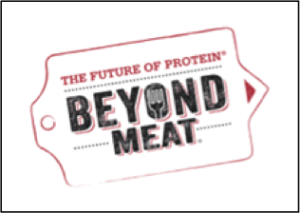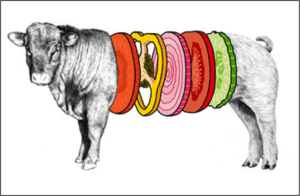Where’s the Beef (Going)?

Diets have changed throughout time, and current food consumption patterns, which are impacting global climate change, may result in radical changes in what we eat in the future
Fundamentally throughout human history, we have sought food for survival in order to provide essential nutrients to fuel existence. Diets have changed throughout time, and current food consumption patterns, which are impacting global climate change, will elicit responses from the food industry. Specifically, beef production and consumption patterns throughout the world are contributing to climate change and will soon face constraints as rising greenhouse gas (GHG) emissions cannot continue at current trends and therefore must be reduced. Tyson Foods, Inc. is the largest beef producer in the United States and will need to revaluate its operating and business models and adapt as a result of climate change [1].
Current State
Presently, meat production as a whole accounts for approximately “15% [to] 24% of current greenhouse gas emissions” [2]. Tyson’s beef production directly contributes to climate change by increasing GHG emission and decreasing the supply of water and land through consumption. Under current production practices, feed used in beef production results in direct methane and nitrous oxide emissions from livestock to the local environment and atmosphere [3]. Methane and nitrous oxide are potent greenhouse gases that directly contribute to global warming at a higher rate than carbon dioxide. In addition to emissions from biogas production, Tyson’s operating model also burns fossil fuels in powering production facilities, transportation, and refrigeration.
Future State
As Tyson faces the constraints imposed by increasing population and overall beef consumption, Tyson must reconcile these demands with limitations in supply due to capacity and more importantly worldwide requirements to decrease GHG emissions. Furthermore, the constraints on water availability and impact of increased extreme weather could potentially result in destruction of livestock and useable land.
Tyson is internally motivated to begin to decrease GHG emissions in order to reduce risk and increase long-term survival to meet increasing demands. In the future, Tyson could also be externally motivated to respond to pressures from regulatory bodies and possibly activists as society addresses climate change by reducing or limiting impact.
Source: [4]
How Tyson is Responding
Tyson is taking steps to address effects through transparency and expansion into substitute products. Tyson publicly states its sustainability mission and also releases sustainability reports on its website which includes reporting a high-level overview of GHG emissions specifically as a result of meat production. For example, in 2011 Tyson reported absolute GHG emissions of 5.20 million tons per year, representing several meat products [4]. Also in the sustainability report, Tyson identifies practices and technologies to conserve water reuse that decreased water usage in production. On the innovative front, Tyson is exploring alternative supplies of new protein rich sources through investments in target companies such as one recently announced in Beyond Meat [5]. Beyond Meat is developing plant protein as a means to deliver sustainable protein for the future.
Source: Dan Fastenberg, “Weekday Vegetarians” (time.com, Aug 23, 2010)
Additional Steps for Tyson
Tyson has begun the journey to reducing its impact on climate change through transparency of current GHG emission and water consumption as well as investing in substitutive protein products. However, Tyson is missing opportunities to further reduce and mitigate greenhouse gas release. Rather than reducing production and GHG, Tyson is expanding production as evidenced by a recent announcement to grow capacity for beef production that is contradictory to its sustainability movement [6]. While Tyson is left unchecked for limiting GHG emissions, it might continue to increase contribution to climate change. Tyson could set metrics related to decreasing GHG emissions but states it is delaying setting goals due to “uncertainty surrounding the legislative and scientific discussions related to climate change” [4]. With Tyson’s large bargaining power as the largest producer of beef in the US, Tyson could push on upstream suppliers to encourage sustainable farming practices by only sourcing from specific suppliers that demonstrate conservative agricultural practices. Furthermore, since Tyson will be constrained in supplying beef to a growing population, it would be wise to continue to explore protein rich alternatives to beef such as grains (i.e. quinoa), beans, nuts, and seeds. As GHG levels continue to rise and climate change evolves, it might only be a matter of time until we witness a new era in the human diet as beef consumption declines and plant-based protein substitute consumption increases.
(Word Count: 704)
References:
[1] National Cattlemen’s Beef Association, “2015 National Cattlemen Directions Statistics.” http://www.beefusa.org/CMDocs/BeefUSA/Producer%20Ed/2015%20CattleFax%20section.pdf, accessed November 2016.
[2] Nathan Fiala, “Meeting the demand: An estimation of potential future greenhouse gas emissions from meat production,” Ecological Economics, 67 (2008) 412-419. via Elsevier, accessed November 2016.
[3] Anthony J McMichael, John W Powles, Colin D Butler, Ricardo Uauy, “Food, livestock production, energy, climate change, and health,” Lancet, 370 (2007) 1253-63. via ScienceDirect, accessed November 2016.
[4] Tyson Foods, Inc., “Sustainability Report 2012,” http://www.tysonsustainability.com/2012/section-4/4_5, accessed November 2016.
[4] Tyson Foods, Inc. “Beyond Meat and Tyson Foods Announce Investment Agreement.” press release, October 10, 2016. Tyson Foods, Inc. website [http://www.tysonfoods.com/media/news-releases/2016/10/beyond-meat-and-tyson-foods-announce-investment-agreement], accessed November 2016.
[5] Tyson Foods, Inc. “Tyson Fresh Meats Announces Council Bluffs Expansion.” press release, September 27, 2016. Tyson Foods, Inc. website [http://www.tysonfoods.com/media/news-releases/2016/09/tyson-fresh-meats-announces-council-bluffs-expansion], accessed November 2016.






It was very interesting to see how a food giant like Tyson is responding to the threat of climate change. Based on what you’e found, it seems like they’re not doing nearly as much as they could be to improve the sustainability of their operations. If the food industry in particular, it does seem like there are some disruptive emerging technologies that will pose a threat to Tyson in the near future. For example, generically engineered substitutes are becoming increasing sophisticated. Tyson must be aware of this technology and I would be very interested to hear whether they have considered what they will to do fight off competition from these types of competitors. It seems that the threat of global climate change has not been enough to radically change Tyson’s operating policies, so maybe competition will be more successful in driving change within these large companies.
It seems to me like Tyson is trying to mitigate the bad publicity they have received in several articles and documentaries regarding the GHG emissions generated by beef production by claiming to be working on sustainable goals.
I find it curious that they are moving towards plant proteins which are direct substitutes for their main products, is this an attempt at diversification? It will be interesting to see how they would market these plant-based protein products. Will it be as a superior product to their core product or as something completely unrelated? Since getting attention towards this plant based product might cannibalize their beef demand.
ASP, great post! Enjoyed reading every part of it. With the environmental effects of livestock, what would happen if Tyson stabilized (or reduced) meat production and increased meat prices? Since Tyson has invested in a plant-based company, Beyond Meats, I could see Beyond Meats as being the “low cost” alternative to Tyson’s real meat. I generally like that Tyson has recognized their need to diversify and has invested in Beyond Meat as a means to do so.
Also, would you propose Tyson to also invest or acquire another start-up, Memphis Meats? They are making “clean meat” (cultured) in a lab. It is very expensive right now, but as the technology improves and consumer demand increases I believe it could be a viable solution. With consumer’s love of meat, do you see lab-grown meat as a real solution or a red herring?